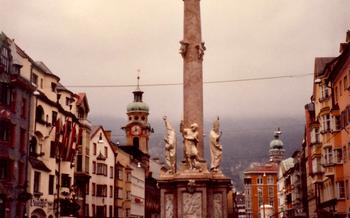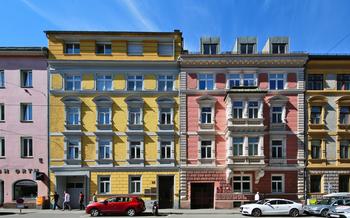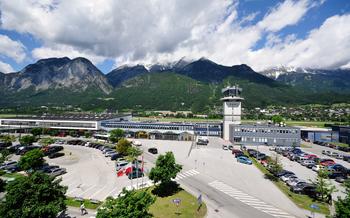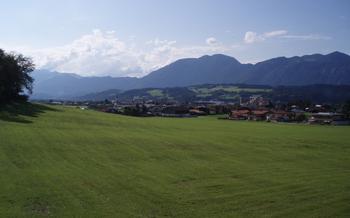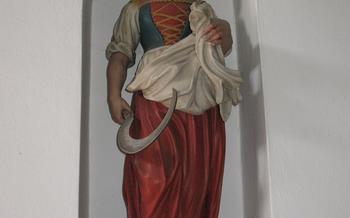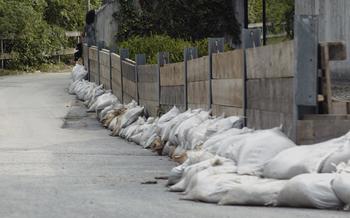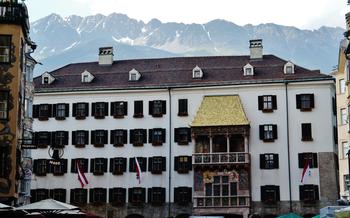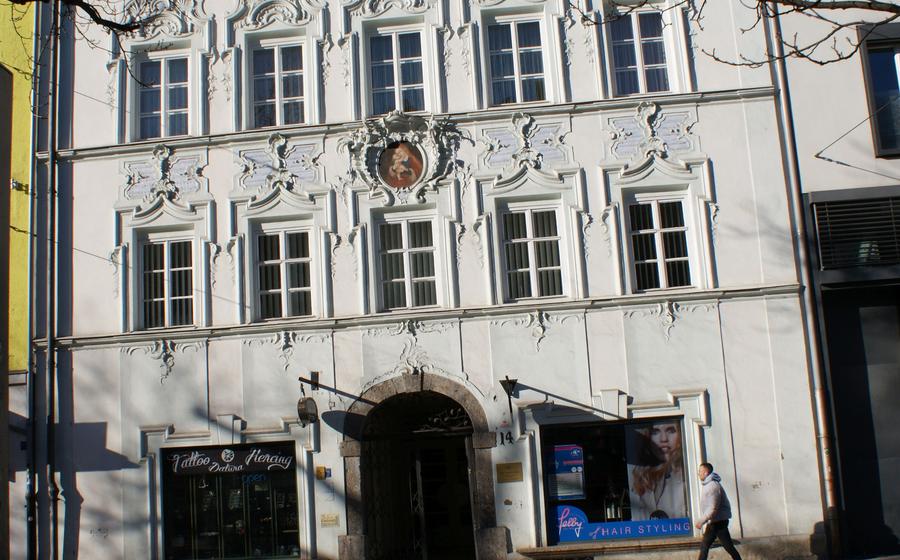
Museum of Tyrolean Regional Heritage (Museum Tiroler Volkskunst)
- The Museum of Tyrolean Regional Heritage: A Journey into Tyrolean Culture
- Traditional Costumes: A Symphony of Colors and Craftsmanship
- The Art of Wood Carving: From Simple to Sublime
- Tyrolean Furniture: Form and Function in Harmony
- Religious Art: Devotion and Artistic Expression
- Textiles and Embroidery: A Tapestry of Skill and Creativity
- Pottery and Ceramics: Earthenware Treasures
- Musical Instruments: Melodies from the Mountains
- Temporary Exhibitions: A Window into Contemporary Tyrolean Art
- Guided Tours: Unveiling the Stories Behind the Artifacts
- Museum Shop: A Treasure Trove of Tyrolean Crafts
- Accessibility: Ensuring an Inclusive Experience
- Educational Programs: Engaging with Tyrolean Heritage
- Planning Your Visit: Essential Information
- Insider Tip: Hidden Gems
The Museum of Tyrolean Regional Heritage: A Journey into Tyrolean Culture
Nestled in the heart of Innsbruck, Austria, the Museum of Tyrolean Regional Heritage stands as a testament to the rich cultural tapestry of the Tyrol region. Established in 1888, this esteemed institution has dedicated itself to preserving and showcasing the unique traditions, arts, and crafts of Tyrol. As you step through its doors, you will embark on a captivating journey into the soul of this captivating Alpine region.
Located at Maria-Theresien-Strasse 51, 6020 Innsbruck, Austria, the museum occupies a prominent position in the city's cultural landscape. Its impressive collection of artifacts, spanning centuries of Tyrolean history, offers visitors a comprehensive Einblick into the region's identity and heritage. Through interactive exhibits, engaging storytelling, and stunning displays, the Museum of Tyrolean Regional Heritage invites you to experience the essence of Tyrol.
Traditional Costumes: A Symphony of Colors and Craftsmanship
The Museum of Tyrolean Regional Heritage houses a mesmerizing collection of traditional Tyrolean costumes, each a testament to the region's rich cultural heritage. These vibrant garments, meticulously crafted by skilled artisans, showcase a symphony of colors, intricate embroidery, beading, and tailoring techniques.
Discover the iconic "Dirndl," a traditional dress worn by women, featuring a fitted bodice, a full skirt, and an apron adorned with intricate patterns. Admire the "Lederhose," a staple of men's attire, made from supple leather and often embellished with elaborate embroidery and decorative buttons.
Learn about the significance of these costumes in Tyrolean culture, where they play a central role in festivals, weddings, and daily life. Each costume tells a story, reflecting the wearer's region, social status, and personal style. Whether it's the festive "Tracht" worn during joyous celebrations or the more subdued "Alltagsgewand" for everyday wear, these garments offer a glimpse into the lives and traditions of the Tyrolean people.
The Art of Wood Carving: From Simple to Sublime
In the heart of the Museum of Tyrolean Regional Heritage, visitors are transported to a realm where wood comes alive under the skilled hands of Tyrolean artisans. Marvel at exquisite wood carvings that range from small figurines to elaborate religious sculptures, each piece a testament to the region's rich artistic tradition.
Discover the diverse techniques employed by these master carvers, from simple whittling to intricate chip carving and the delicate art of relief carving. Each stroke of the chisel reveals the depth and complexity of their artistry, as they transform ordinary wood into extraordinary works of art.
Delve into the symbolic meanings and stories behind the carved motifs, which often draw inspiration from Tyrolean folklore, religious traditions, and the natural world. From whimsical animals and mythical creatures to scenes of everyday life, each carving tells a unique tale that captivates the imagination.
Whether you're an art enthusiast, a history buff, or simply someone who appreciates the beauty of craftsmanship, the Museum of Tyrolean Regional Heritage offers a captivating journey into the world of wood carving, where the simple becomes sublime.
Tyrolean Furniture: Form and Function in Harmony
Tyrolean furniture, a testament to the region's rich craftsmanship, occupies a prominent place within the museum's collection. Discover a diverse array of furniture styles, from rustic farmhouse pieces that exude a sense of warmth and functionality, to elegant baroque designs that showcase intricate carvings and opulent ornamentation.
Local woods, such as pine, spruce, and larch, form the foundation of these furniture masterpieces, lending them a distinct character and durability. Craftsmen employed traditional woodworking techniques, meticulously shaping and joining each piece with precision and care.
Admire the attention to detail in the intricate carvings that adorn many of the furniture pieces. These carvings often depict scenes from everyday life, religious motifs, or mythical creatures, reflecting the cultural and artistic influences that shaped Tyrolean society.
Each piece of furniture tells a unique story, showcasing the skill and artistry of Tyrolean craftsmen. Whether it's a simple farmhouse table that evokes a sense of nostalgia, or an elaborate baroque cabinet that exudes grandeur, these furniture pieces embody the essence of Tyrolean heritage.
Religious Art: Devotion and Artistic Expression
The Museum of Tyrolean Regional Heritage houses a remarkable collection of religious art that reflects the deep-rooted Catholic faith of the Tyrolean people. Masterpieces from different periods, ranging from the Middle Ages to the Baroque era, showcase the talent and devotion of Tyrolean artists.
Sacred paintings, sculptures, and altars adorn the museum's galleries, each telling a story of faith, hope, and redemption. Gaze upon stunning depictions of the Madonna and Child, intricately carved wooden crucifixes, and elaborate altarpieces that shimmer with gold leaf and vibrant colors.
Explore the diverse techniques employed by Tyrolean religious artists, from the delicate brushstrokes of Renaissance painters to the expressive carvings of Baroque sculptors. Discover the iconography and symbolism commonly found in religious artworks, such as the lamb representing Christ, the dove symbolizing the Holy Spirit, and the keys representing the authority of St. Peter.
These sacred treasures offer a glimpse into the spiritual world of the Tyrolean people, where art and devotion intertwine to create a profound sense of awe and inspiration.
Textiles and Embroidery: A Tapestry of Skill and Creativity
Step into the enchanting world of Tyrolean textiles and embroidery at the Museum of Tyrolean Regional Heritage. Discover a treasure trove of intricately woven fabrics and exquisitely embroidered pieces that showcase the remarkable skills and artistry of Tyrolean craftswomen.
Delve into the diverse range of textiles on display, from sturdy linens and sumptuous velvets to delicate lace and gossamer-like silks. Admire the vibrant colors and intricate patterns that adorn these fabrics, each telling a unique story about Tyrolean culture and traditions.
Explore the various embroidery techniques employed by Tyrolean artisans, including cross-stitch, needlepoint, and appliqué. Marvel at the intricate designs and motifs that grace traditional garments, household linens, and religious vestments, demonstrating the exceptional craftsmanship and attention to detail that characterize Tyrolean embroidery.
Learn about the cultural significance of textiles in Tyrolean society, from their everyday use in clothing and household items to their special role in festive occasions and religious ceremonies. Discover how textiles and embroidery have been integral to Tyrolean identity and self-expression throughout history.
Immerse yourself in the rich tapestry of Tyrolean textile arts, and gain a deep appreciation for the skill, creativity, and cultural heritage that these beautiful creations embody.
Pottery and Ceramics: Earthenware Treasures
In the Museum of Tyrolean Regional Heritage, a dedicated section showcases the rich tradition of pottery and ceramics in the Tyrol region. Here, visitors can delve into the world of handcrafted earthenware treasures that reflect the region's distinct artistic heritage.
The museum's collection features a diverse range of pottery and ceramics from different regions of Tyrol. From the delicate porcelain of the Zillertal Valley to the rustic stoneware of the Ötztal Valley, each piece showcases the unique styles and techniques that have been passed down through generations of Tyrolean potters.
Visitors can admire the intricate craftsmanship and attention to detail that goes into the creation of these earthenware treasures. From wheel-thrown forms to hand-painted designs, each piece is a testament to the skill and artistry of Tyrolean craftsmen.
The exhibits also explore the traditional methods of pottery making, including wheel throwing, glazing, and firing. Visitors can learn about the different types of clay used, the processes involved in creating pottery, and the significance of the various glazes and firing techniques.
The pottery and ceramics collection at the Museum of Tyrolean Regional Heritage offers a fascinating glimpse into a vital aspect of Tyrolean culture. Through these earthenware creations, visitors can appreciate the artistry and craftsmanship that have been passed down through generations, shaping the region's unique heritage.
Musical Instruments: Melodies from the Mountains
In the heart of the Tyrolean Alps, music has always played a vital role in the region's culture and traditions. At the Museum of Tyrolean Regional Heritage, a dedicated section is devoted to the exploration of traditional Tyrolean musical instruments. Here, visitors are invited to embark on a journey through the melodies of the mountains.
The museum's collection houses a diverse array of instruments, each with its own unique story to tell. From the haunting melodies of the zither to the cheerful tones of the accordion, these instruments have provided the soundtrack to countless Tyrolean festivals, celebrations, and daily life.
Visitors can admire the intricate craftsmanship and attention to detail that went into the making of these instruments. Many were handcrafted by local artisans using traditional methods passed down through generations. The zithers, for example, are known for their delicate sound and beautifully carved bodies, while the accordions feature intricate designs and mother-of-pearl inlays.
Beyond their aesthetic appeal, these instruments hold deep cultural significance. The zither, with its soft, lilting sound, was a favorite instrument of Tyrolean folk musicians and was often played at traditional gatherings and dances. The accordion, on the other hand, gained popularity in the 19th century and quickly became a staple of Tyrolean brass bands, adding a lively and festive touch to local festivities.
Through interactive displays and listening stations, visitors can immerse themselves in the sounds of Tyrolean music. They can listen to traditional Tyrolean folk songs, dance tunes, and religious hymns, gaining a deeper appreciation for the region's rich musical heritage.
Temporary Exhibitions: A Window into Contemporary Tyrolean Art
In addition to its permanent collection, the Museum of Tyrolean Regional Heritage regularly hosts temporary exhibitions that showcase contemporary Tyrolean art. These exhibitions offer a platform for local and regional artists to display their works and explore a wide range of themes and artistic expressions.
Themes covered in these exhibitions can vary greatly, from traditional Tyrolean motifs and landscapes to abstract and experimental works. Visitors can expect to encounter paintings, sculptures, photography, installations, and mixed media pieces that reflect the diverse creative landscape of contemporary Tyrol.
Temporary exhibitions provide an opportunity to discover emerging talents and established artists alike. They offer a glimpse into the current trends and developments in Tyrolean art, allowing visitors to engage with the vibrant and dynamic contemporary art scene of the region.
To stay updated on current and upcoming exhibitions, visitors are encouraged to check the museum's website or social media channels. Guided tours of temporary exhibitions may also be available, providing visitors with insights into the artists' inspiration, techniques, and creative processes.
By supporting temporary exhibitions, the Museum of Tyrolean Regional Heritage plays a vital role in fostering and promoting contemporary Tyrolean art. These exhibitions offer a platform for artists to share their unique perspectives and contribute to the cultural richness of the region.
Guided Tours: Unveiling the Stories Behind the Artifacts
Enhance your visit to the Museum of Tyrolean Regional Heritage by booking a guided tour. Knowledgeable guides will lead you through the exhibits, sharing fascinating stories and historical context that bring the artifacts to life. Learn about the significance of traditional costumes, the symbolism behind wood carvings, and the techniques used to create exquisite Tyrolean furniture.
Guided tours are available in English and other languages, ensuring that visitors from all over the world can gain a deeper understanding of Tyrolean culture. Advance booking is recommended, especially during peak tourist season, to secure your spot and avoid disappointment. Immerse yourself in the rich heritage of Tyrol and discover the hidden stories behind the museum's remarkable collection.
Museum Shop: A Treasure Trove of Tyrolean Crafts
Step into the museum shop and be greeted by a treasure trove of Tyrolean craftsmanship and creativity. Here, you'll find a curated selection of high-quality souvenirs, handicrafts, and local products that embody the spirit of the region. Browse through traditional clothing, accessories, and homeware, each piece meticulously crafted to reflect the rich cultural heritage of Tyrol.
Whether you're looking for a unique gift for friends and family or a special souvenir to cherish your memories of Innsbruck, the museum shop offers a wide range of options. Support local artisans and craftsmen by purchasing from the shop, ensuring that the traditions and skills of the region continue to thrive.
From intricate wood carvings and hand-painted ceramics to finely embroidered textiles and traditional musical instruments, the museum shop offers a diverse collection of authentic Tyrolean crafts. Take home a piece of Tyrolean culture to adorn your home or remind you of your travels in this beautiful region.
Accessibility: Ensuring an Inclusive Experience
The Museum of Tyrolean Regional Heritage is committed to providing an inclusive and accessible experience for all visitors. The museum's facilities are designed to accommodate visitors with disabilities, including wheelchair accessibility, elevators, and accessible restrooms. Visitors with special needs can request assistance from museum staff, who are always available to provide information and guidance. The museum also offers guided tours in sign language and audio descriptions for visitors with visual impairments. Educational programs and workshops are also adapted to meet the needs of visitors with disabilities, ensuring that everyone has the opportunity to engage with and appreciate Tyrolean heritage.
Educational Programs: Engaging with Tyrolean Heritage
The Museum of Tyrolean Regional Heritage offers a range of educational programs that provide visitors with opportunities to delve deeper into Tyrolean culture and traditions. Whether you're a curious traveler, a student, or a lifelong learner, these programs offer unique and interactive experiences.
Attend a workshop or demonstration to learn firsthand from skilled artisans who will guide you through the processes of traditional Tyrolean crafts such as wood carving, embroidery, or pottery. These hands-on experiences allow you to create your own souvenirs while gaining insights into the techniques and skills that have been passed down through generations.
The museum also organizes lectures and talks by experts in Tyrolean history, art, and culture. These presentations offer fascinating insights into various aspects of Tyrolean heritage, from the region's unique geography and traditions to the lives and works of influential Tyrolean artists and thinkers.
Educators and group leaders can arrange for tailored educational programs for school groups. These programs are designed to align with curriculum standards and provide students with interactive learning experiences that bring Tyrolean history and culture to life. Through guided tours, workshops, and hands-on activities, students can explore the museum's exhibits and gain a deeper understanding of the region's rich heritage.
Planning Your Visit: Essential Information
Before embarking on your journey to the Museum of Tyrolean Regional Heritage, it's essential to plan your visit to ensure a smooth and enriching experience.
-
Hours: The museum's opening hours vary seasonally, so it's advisable to check their website for the most up-to-date information. This will help you plan your visit accordingly and avoid any disappointment.
-
Admission: Ticket prices are subject to change, but generally, there is a standard admission fee for adults, with discounts available for seniors, students, and children. The museum also offers special offers and group rates, so it's worth inquiring about these options if you're traveling with a larger group.
-
Location: The Museum of Tyrolean Regional Heritage is conveniently situated in the heart of Innsbruck, at Maria-Theresien-Strasse 51, 6020 Innsbruck, Austria. Its central location makes it easily accessible on foot or by public transportation from other attractions in the city.
By planning your visit in advance, you can make the most of your time at the museum, immersing yourself in the rich cultural heritage of Tyrol and creating lasting memories.
Insider Tip: Hidden Gems
Beyond the main galleries, the Museum of Tyrolean Regional Heritage holds a few hidden gems waiting to be discovered by curious visitors. One such treasure is the secret room, which can be accessed by asking a museum staff member. This room houses a special collection of rare and unique artifacts that offer a glimpse into the lesser-known aspects of Tyrolean culture. From ancient tools and utensils to intricate pieces of jewelry, each item tells a fascinating story about the region's rich past.
Another hidden gem is the rooftop terrace, which offers panoramic views of Innsbruck and the stunning Tyrolean Alps. Take a break from exploring the exhibits and step onto the terrace to soak in the breathtaking scenery. Admire the city's colorful rooftops, the majestic Nordkette mountains, and the sparkling Inn River meandering through the valley. Whether you're looking for a moment of tranquility or a unique photo opportunity, the rooftop terrace is a must-visit spot for every visitor to the museum.
